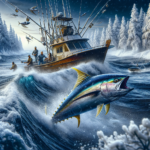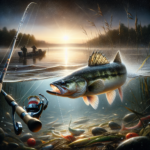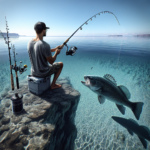Winter Yellowfin Tuna Fishing in Florida’s Atlantic Coast

Introduction
Did you know that the Atlantic coast of Florida is one of the premier destinations for winter Yellowfin Tuna fishing? This article will delve into the intricacies of Yellowfin Tuna fishing along Florida’s Atlantic coast during the winter months. We will cover everything from the best fishing techniques and gear to the top fishing spots and seasonal considerations. Whether you are a seasoned angler or a novice looking to try your hand at catching this prized species, this guide will provide you with all the information you need.
Winter Yellowfin Tuna fishing in Florida is not just a pastime; it’s a thrilling adventure that offers both challenges and rewards. Understanding the best techniques, knowing where to fish, and being aware of the seasonal variations can significantly enhance your fishing experience. This article aims to equip you with the knowledge and tools necessary to make the most of your winter fishing trips.
Background/Context
Historical or Cultural Significance
Yellowfin Tuna, also known as Thunnus albacares, have long been a staple in both commercial and recreational fishing. Historically, these fish have been highly valued for their size, strength, and culinary qualities. In Florida, Yellowfin Tuna fishing has become a cultural tradition, attracting anglers from all over the world.
Geographical Overview
Florida’s Atlantic coast offers a unique ecosystem that is ideal for Yellowfin Tuna. The Gulf Stream, a warm ocean current, runs close to the coast, creating a rich environment for various marine species. The climate is generally mild during the winter months, making it an excellent time for fishing. The topography includes deep waters and underwater structures that are perfect habitats for Yellowfin Tuna.
Key Points/Details
Fishing Techniques
Technique Overview
When it comes to Yellowfin Tuna fishing, several techniques can be employed. Trolling, chunking, and live bait fishing are among the most popular methods. Trolling involves dragging lures or bait behind a moving boat, while chunking uses pieces of fish to attract Tuna. Live bait fishing, as the name suggests, uses live fish to lure Yellowfin Tuna.
When and Where to Use
Trolling is most effective in open waters where Yellowfin Tuna are likely to be swimming near the surface. Chunking is best used when you are anchored or drifting in areas known to have high Tuna activity. Live bait fishing can be employed in both scenarios but is particularly effective in areas with underwater structures.
Recommended Gear
- Rods: Heavy-duty rods capable of handling large fish.
- Reels: High-capacity reels with strong drag systems.
- Lines: Braided lines with a high pound-test rating.
- Bait/Lures: Live bait such as mackerel or squid, and lures like poppers and jigs.
Species Information
Species Overview
Yellowfin Tuna are known for their speed and strength, making them a challenging catch. They prefer warm waters and are often found in the open ocean. During the winter months, they migrate closer to the Florida coast, following the Gulf Stream.
Best Practices
To successfully catch Yellowfin Tuna, it’s essential to use the right techniques and gear. Trolling at speeds of 6-8 knots with brightly colored lures can attract Tuna. When chunking, use fresh bait and maintain a steady stream of chunks to keep the fish interested. For live bait fishing, ensure your bait is lively and hook it in a way that allows it to swim naturally.
Location Information
Top Fishing Spots
- Stuart: Known as the “Sailfish Capital of the World,” Stuart also offers excellent Yellowfin Tuna fishing.
- West Palm Beach: The Gulf Stream is closest to the shore here, making it a prime spot for Tuna fishing.
- Fort Lauderdale: Offers deep waters and underwater structures that attract Yellowfin Tuna.
Regulations and Licenses
Before heading out, make sure you are aware of the local fishing regulations. A Florida saltwater fishing license is required for all anglers. There are also specific regulations regarding the size and number of Yellowfin Tuna that can be caught. Always check the latest guidelines from the Florida Fish and Wildlife Conservation Commission.
Seasonal Considerations
Seasonal Variations
Winter is an excellent time for Yellowfin Tuna fishing along Florida’s Atlantic coast. The cooler water temperatures and the proximity of the Gulf Stream make it an ideal season. However, weather conditions can be unpredictable, so it’s essential to stay updated on forecasts.
Best Times to Fish
The best time to fish for Yellowfin Tuna is during the early morning or late afternoon when they are most active. The winter months, from December to February, offer the best opportunities due to the migration patterns of the Tuna.
Events and Tournaments
Event Overview
Florida hosts several fishing tournaments during the winter months, including the prestigious “Sailfish Challenge” and “Silver Sailfish Derby.” While these events primarily focus on Sailfish, they also offer categories for Yellowfin Tuna.
Preparation Tips
To prepare for these events, ensure your gear is in top condition. Practice your techniques and familiarize yourself with the tournament rules. Pre-fishing the area can also give you a competitive edge.
Tips and Best Practices
General Tips
- Always use fresh bait to increase your chances of attracting Yellowfin Tuna.
- Maintain a steady trolling speed to keep your lures at the optimal depth.
- Use a fish finder to locate schools of Tuna.
Avoid Common Mistakes
- Don’t use old or damaged gear; it can fail when you hook a large Tuna.
- Avoid fishing in areas with heavy boat traffic; it can scare away the fish.
- Don’t ignore weather forecasts; rough seas can make fishing dangerous.
Advanced Techniques
- Use kite fishing to present live bait on the surface, mimicking injured fish.
- Employ deep-dropping techniques to reach Tuna swimming at greater depths.
- Experiment with different lure colors and sizes to find what works best.
Gear and Equipment Recommendations
Essential Gear
- Heavy-duty rods and reels
- Braided fishing lines
- Live bait and lures
- Fish finder
- Gaff and landing net
Optional Gear/Upgrades
- Kite fishing setup
- Downriggers for deep-dropping
- High-quality cooler for storing your catch
Where to Buy or Rent
Local shops like Bass Pro Shops and West Marine offer a wide range of fishing gear. Online stores such as Amazon and TackleDirect also provide extensive options. For rentals, check out local marinas and bait shops.
Safety and Conservation
Safety Tips
- Always wear a life jacket when on the water.
- Check weather forecasts before heading out.
- Inform someone of your fishing plans and expected return time.
Conservation Practices
- Practice catch and release to help sustain the Yellowfin Tuna population.
- Follow local regulations regarding size and catch limits.
- Dispose of fishing lines and hooks properly to protect marine life.
Planning Your Trip
Accommodations
There are numerous hotels and resorts along Florida’s Atlantic coast. Some popular options include the Hutchinson Island Marriott Beach Resort in Stuart and the Hilton West Palm Beach.
Travel Tips
Florida’s Atlantic coast is easily accessible via major highways and airports. Renting a car is recommended for convenience. Be sure to check for any travel advisories or road conditions before your trip.
Additional Activities
When you’re not fishing, explore other activities such as snorkeling, diving, and visiting local attractions like the Kennedy Space Center or the Miami Seaquarium.
Frequently Asked Questions (FAQs)
What is the best time of year to fish for Yellowfin Tuna in Florida?
The winter months, from December to February, are the best time for Yellowfin Tuna fishing along Florida’s Atlantic coast.
Do I need a fishing license to fish for Yellowfin Tuna in Florida?
Yes, a Florida saltwater fishing license is required for all anglers.
What gear do I need for Yellowfin Tuna fishing?
Essential gear includes heavy-duty rods and reels, braided lines, live bait, lures, and a fish finder.
Conclusion
Winter Yellowfin Tuna fishing along Florida’s Atlantic coast offers an exhilarating experience for anglers of all skill levels. By understanding the best techniques, knowing where to fish, and being aware of seasonal variations, you can significantly enhance your chances of a successful catch. Remember to follow local regulations, practice conservation, and prioritize safety. Now that you’re equipped with all the necessary information, it’s time to plan your trip and embark on an unforgettable fishing adventure.




